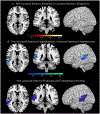Common and distinct neural substrates of sentence production and comprehension
- PMID: 32949711
- PMCID: PMC10134242
- DOI: 10.1016/j.neuroimage.2020.117374
Common and distinct neural substrates of sentence production and comprehension
Abstract
Functional neuroimaging and lesion-symptom mapping investigations implicate a left frontal-temporal-parietal network for sentence processing. The majority of studies have focused on sentence comprehension, with fewer in the domain of sentence production, which have not fully elucidated overlapping and/or unique brain structures associated with the two domains, particularly for sentences with noncanonical word order. Using voxel-based lesion symptom mapping (VLSM) we examined the relationship between lesions within the left hemisphere language network and both sentence comprehension and production of simple and complex syntactic structures in 76 participants with chronic stroke-induced aphasia. Results revealed shared regions across domains in the anterior and posterior superior temporal gyri (aSTG, pSTG), and the temporal pole (adjusted for verb production/comprehension). Additionally, comprehension was associated with lesions in the anterior and posterior middle temporal gyri (aMTG, pMTG), the MTG temporooccipital regions, SMG/AG, central and parietal operculum, and the insula. Subsequent VLSM analyses (production versus comprehension) revealed critical regions associated with each domain: anterior temporal lesions were associated with production; posterior temporo-parietal lesions were associated with comprehension, implicating important roles for regions within the ventral and dorsal stream processing routes, respectively. Processing of syntactically complex, noncanonical (adjusted for canonical), sentences was associated with damage to the pSTG across domains, with additional damage to the pMTG and IPL associated with impaired sentence comprehension, suggesting that the pSTG is crucial for computing noncanonical sentences across domains and that the pMTG, and IPL are necessary for re-analysis of thematic roles as required for resolution of long-distance dependencies. These findings converge with previous studies and extend our knowledge of the neural mechanisms of sentence comprehension to production, highlighting critical regions associated with both domains, and further address the mechanism engaged for syntactic computation, controlled for the contribution of verb processing.
Keywords: Aphasia; Sentence processing; Syntax; Voxel-based lesion-symptom mapping.
Copyright © 2020. Published by Elsevier Inc.
Figures



Similar articles
-
Damage to left anterior temporal cortex predicts impairment of complex syntactic processing: a lesion-symptom mapping study.Hum Brain Mapp. 2013 Oct;34(10):2715-23. doi: 10.1002/hbm.22096. Epub 2012 Apr 21. Hum Brain Mapp. 2013. PMID: 22522937 Free PMC article.
-
Distinct neural correlates of morphosyntactic and thematic comprehension processes in aphasia.Brain Commun. 2025 Mar 24;7(2):fcaf093. doi: 10.1093/braincomms/fcaf093. eCollection 2025. Brain Commun. 2025. PMID: 40129862 Free PMC article.
-
The role of left temporo-parietal and inferior frontal cortex in comprehending syntactically complex sentences: A brain stimulation study.Neuropsychologia. 2023 Feb 10;180:108465. doi: 10.1016/j.neuropsychologia.2022.108465. Epub 2022 Dec 28. Neuropsychologia. 2023. PMID: 36586718
-
Lesion analysis of the brain areas involved in language comprehension.Cognition. 2004 May-Jun;92(1-2):145-77. doi: 10.1016/j.cognition.2003.11.002. Cognition. 2004. PMID: 15037129 Review.
-
Neurocognitive Recovery of Sentence Processing in Aphasia.J Speech Lang Hear Res. 2019 Nov 22;62(11):3947-3972. doi: 10.1044/2019_JSLHR-L-RSNP-19-0219. Epub 2019 Nov 22. J Speech Lang Hear Res. 2019. PMID: 31756151 Free PMC article. Review.
Cited by
-
Brain-wide functional connectivity alterations and their cognitive correlates in subjective cognitive decline.Front Neurosci. 2024 Aug 1;18:1438260. doi: 10.3389/fnins.2024.1438260. eCollection 2024. Front Neurosci. 2024. PMID: 39148525 Free PMC article.
-
Brain Areas Critical for Picture Naming: A Systematic Review and Meta-Analysis of Lesion-Symptom Mapping Studies.Neurobiol Lang (Camb). 2023 Apr 11;4(2):280-296. doi: 10.1162/nol_a_00097. eCollection 2023. Neurobiol Lang (Camb). 2023. PMID: 37229507 Free PMC article.
-
Verbal working memory and syntactic comprehension segregate into the dorsal and ventral streams, respectively.Brain Commun. 2024 Dec 11;6(6):fcae449. doi: 10.1093/braincomms/fcae449. eCollection 2024. Brain Commun. 2024. PMID: 39713237 Free PMC article.
-
Intraoperative cortical localization of music and language reveals signatures of structural complexity in posterior temporal cortex.iScience. 2023 Jun 28;26(7):107223. doi: 10.1016/j.isci.2023.107223. eCollection 2023 Jul 21. iScience. 2023. PMID: 37485361 Free PMC article.
-
Canonical Sentence Processing and the Inferior Frontal Cortex: Is There a Connection?Neurobiol Lang (Camb). 2022 Apr 13;3(2):318-344. doi: 10.1162/nol_a_00067. eCollection 2022. Neurobiol Lang (Camb). 2022. PMID: 37215558 Free PMC article.
References
Publication types
MeSH terms
Grants and funding
LinkOut - more resources
Full Text Sources
Other Literature Sources
Medical

